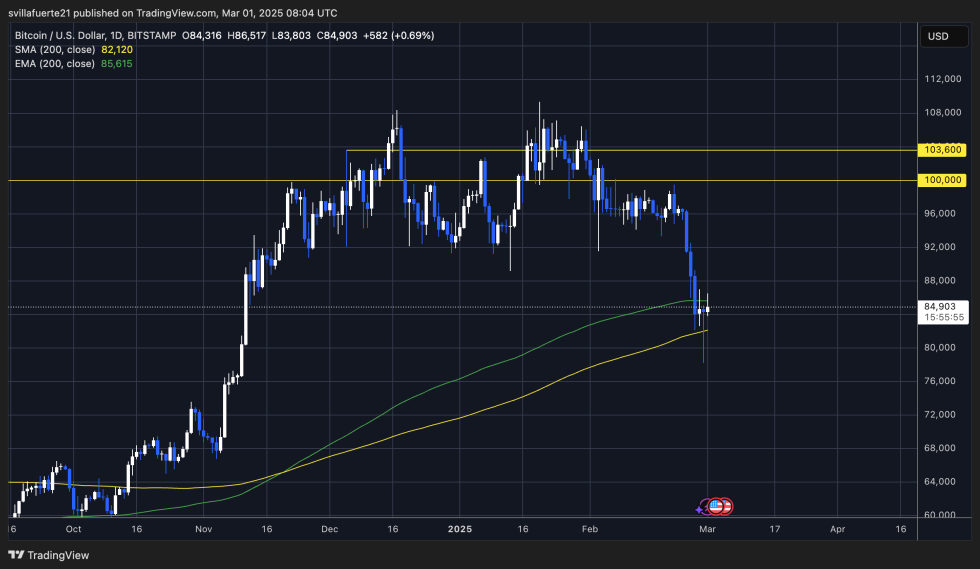Bitcoin is trading below key weekly demand levels, forming new lows as market uncertainty continues to dominate. The ongoing correction has led to increased speculation about US trade war fears and potential obstacles for Bitcoin’s adoption as a US reserve asset. These macroeconomic concerns have added pressure to an already fragile crypto market, causing investors to question the sustainability of the current bull cycle.
A CryptoQuant report highlights another critical factor influencing BTC’s price action—declining stablecoin reserves. The report states that if stablecoin reserves continue to drop, crypto liquidity could tighten further, making it more difficult for Bitcoin to stage a major recovery in the near term. Stablecoin reserves act as dry powder for crypto investors, allowing for quick market entries and exits. A decrease in these reserves signals less buying power in the market, reducing the chances of a strong BTC rally.
With Bitcoin already facing strong selling pressure and macroeconomic uncertainty weighing on sentiment, the next few weeks will be crucial. If liquidity continues to decline, BTC may struggle to reclaim key levels, delaying any significant upside movement. Investors are now watching stablecoin reserves and broader market conditions to gauge Bitcoin’s next move.
Bitcoin Liquidity Is The Key
Bitcoin is navigating a volatile and uncertain market environment shaped by trade wars, evolving technology, and global economic instability. The crypto market is struggling as investor sentiment weakens due to increasing macroeconomic concerns. Bitcoin’s price has faced significant pressure, falling below key support levels as negative news and uncertainty dominate. To regain strength, BTC must reclaim the $90K level and hold it as support. Failing to do so puts the entire uptrend at risk, with analysts fearing further drawdowns into lower demand zones.
CryptoQuant’s report sheds light on another crucial factor affecting Bitcoin’s trajectory—a liquidity drain in the crypto market. CryptoQuant analysts ask why crypto demand has weakened, citing declining stablecoin reserves as a major contributing factor.

Stablecoin reserves serve as a critical liquidity source for crypto markets, often reflecting buying power and investor confidence. If stablecoin reserves continue to drop, BTC may struggle to see any major uptrend, as there will be less capital available to support price recovery.
On the other hand, a rebound in stablecoin reserves could be a bullish signal, suggesting fresh capital inflows and renewed demand. If stablecoin reserves begin to rise again, Bitcoin may quickly reclaim key levels and resume its bullish trend. The coming weeks will be crucial in determining whether crypto liquidity recovers or remains weak, delaying BTC’s next move.
BTC Trades Around $85K As Bulls Lose Control
Bitcoin is currently trading at $85,000 after rebounding from the 200-day moving average (MA) at $82,100. This bounce provided a temporary relief for bulls, but BTC is still struggling to reclaim previous levels with strength. The 200-day exponential moving average (EMA) at $85,600 is acting as immediate resistance, and so far, bulls have failed to push the price above this level.

The market remains uncertain, with Bitcoin consolidating between $82K and $86K, unable to confirm a clear recovery or a breakdown into lower demand zones. If BTC can break and hold above the 200-day EMA, a short-term recovery rally could follow, with $88K–$90K as the next upside targets. However, if BTC fails to reclaim $85,600, the price could remain range-bound or even test lower levels again.
The next week will be crucial as Bitcoin’s short-term direction remains unclear. A consolidation phase between $82K and $86K could develop before a larger move in either direction. If selling pressure returns, BTC could revisit the $82K support, and a loss of this level may trigger further downside risk into the $78K–$80K range. Bulls must step in soon to regain control and prevent deeper corrections.
Featured image from Dall-E, chart from TradingView
from Bitcoinist.com https://ift.tt/aie9cwo
Comments
Post a Comment